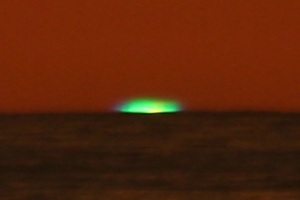From: http://www.csag.uct.ac.za/2013/10/15/the-green-flash/
The green flash or sometimes referred to as Neptune’s Wink has inspired literature, artwork and myths. In the 1882 novel “Le Rayon Vert” Jules Verne describes the phenomenon as “a green which no artist could ever obtain on his palette, a green of which neither the varied tints of vegetation nor the shades of the most limpid sea could ever produce the like! If there is a green in Paradise, it cannot be but of this shade, which most surely is the true green of Hope”. It was through this novel that people thought that there exists an ancient Scottish myth in which someone who sees the green flash is incapable of being “deceived in matters of sentiment” and “he who has been fortunate enough once to behold it is enabled to see closely into his own heart and to read the thoughts of others.” Whether this is a Scottish legend is debatable but other references state that legends have it that a person who sees the green flash will make wise decisions in terms of love. Some believe that the green flash is represented in Hieroglyphics and it was even referred to in the movie “The Pirates of the Caribbean” where it is seen as a sign that a soul has returned to the living.
So what is the green flash? The green flash is seen at sunrise or sunset as a sudden appearance of green just before the sun rises or sets. In order to see the green flash you need a clear view of the horizon, it lasts only a few seconds and requires particular atmospheric conditions for it to occur, thus making it a rare observation and the subject of myths and legends.
Figure 1 Photograph of a green flash taken from the website: http://mintaka.sdsu.edu/GF/explain/obs_colors.html
For many years it was supposed that the green flash was just an afterimage or due to contrast effects in the eyes and existed purely due to the physical make up of the eye. However with the improvement of photography it is now clear that the green flash exists beyond this. The green flash can be explained by physics: dispersion in the atmosphere causes one to see the red colour of a sunset disappear before the yellow then green, blue and violet colours. However, scattering due to air molecules and aerosol particles results in the shortest wavelengths being almost completely removed, making the blue and violet colours nearly invisible. So what remains is a small green rim as the last part of a sunset. This rim is mostly too narrow to be seen by the naked eye. However on days when the temperature gradients in the atmosphere cause a mirage the green colour before the sun disappears is magnified and seen for a few seconds resulting in a sudden flash of green.
There are many different types of green flashes mostly classified by the type of mirage magnifying the green colour of the sunrise or sunset. Here are some of the types of flashes you can get and under what condition you can view them from taken from astronomer Andrew T. Young’s website: http://mintaka.sdsu.edu/GF/papers/Zenit/glance.html
| kind | characteristics | conditions | best seen from … |
| inferior-mirage flash | Joule’s “last glimpse”; oval, flattened below; lasts 1 or 2 seconds | surface warmer than the overlying air | close to sea level |
| mock-mirage flash | indentations seem to “pinch off” a thin, pointy strip from the upper limb of the Sun; duration 1 or 2 sec. | atmospheric inversion layer below eye level; surface colder than air | the higher the eye, the more likely; flash is most obvious when the eye is just above the inversion |
| sub-duct flash | large upper part of an hourglass-shaped Sun turns green for up to 15 sec. | observer below a strong atmospheric inversion | in a narrow height interval just below a duct (can occur at any height) |
| green ray | green beam of light that seems to shoot up from a green flash, or is seen immediately after sundown. Usually only a few degrees long; lasts no longer than a couple of seconds | hazy air and a bright green flash of one of the kinds named above that acts as a light source | ?? |
Figure 2 Table showing some different types of green flashes. The first two are the most commonly viewed while the second two are much rarer and the last one is not known to have been photographed.
The greatest thing about the green flash is that it is has been spotted in Cape Town! People have reported seeing the green flash in Noordhoek, Chapman’s Peak and Table Mountain. So next time you watching the sunset look out for the point at which the very top of the sun is about to disappear below the horizon and maybe you’ll catch a glance of the mysterious green flash.
LINKS
https://www.atoptics.co.uk/atoptics/gf1.htm
https://aty.sdsu.edu/explain/explain.html
Advanced Advice about Green-Flash Photography https://aty.sdsu.edu/observing/photo-advice.html
https://aty.sdsu.edu/explain/simulations/inf-mir/inf-mirSS4.html


Leave a Reply